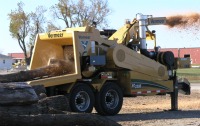
Vermeer introduces whole-tree chipper
December 21, 2010
By Vermeer
 |
 |
|
| Photo: Canadian Biomass
|
Dec. 21, 2010, Pella, IA – Vermeer Corporation is introducing the
WC2300 whole-tree chipper, designed specifically to produce chips for the
growing biomass industry. The WC2300 features many proven technologies developed
by Vermeer.
“We spent considerable time working with
end users to identify what features they thought were missing on current
machines in the marketplace and incorporated those improvements into the WC2300
whole tree chipper,” says Mark Rieckhoff, environmental sales manager for
Vermeer.
Innovations start at the infeed table,
which features a 6º slope that lowers the point at which long material first
contacts the machine. This allows the smooth flow of long material from the
ground up onto the infeed table and reduces the likelihood of limbs or tree
canopy from snagging on the end of the machine.
The actual infeed system features
variable-speed dual conveyor chains on the infeed table, a conveyor head pulley
with integral grip bars, and an aggressive large-diameter infeed roller with
crush capability. These provide efficient feeding of difficult material types,
minimizing operator handling of the material.
The infeed conveyor chains are individually
tensioned to accommodate unequal chain wear and allow replacement of a single
chain at a time. The infeed roller down-pressure, which is monitored by
Vermeer’s SmartCrush system, is minimized until the feed roller has climbed up
onto the material. Down-pressure then increases automatically to feed difficult
material with forks or large limbs to the cutter drum. The SmartFeed
feed-sensing control system monitors engine revolutions per minute and
automatically stops and temporarily reverses the feed roller and infeed
conveyor when feeding larger, hardwood material. SmartFeed also senses feed
roller jams and responds by automatically shifting material back and forth.
This helps increase operator productivity and reduces strain on vital engine
parts.
The chipper’s cutting drum has two knife
options: double-edged or babbitted single-edge cutter knives. This allows the
operator to select the type of knife that best suits the operation, job site,
or customer requirements. In addition, the drum and cutter knife design provide
two different knife-mounting depths of cuts that produce different chip sizes,
allowing one machine to provide different end products to meet the needs of
various end users.
The machine’s functions can be controlled
remotely using a handheld remote control. The remote allows the user to operate
the chipper from another location such as the cab of the loading machine and
provides real-time machine performance data to aid the operator in maximizing
productivity by monitoring and adjusting settings.
The chipper is equipped with a 440-hp
(328.1 kW) C-13 Cat diesel engine that allows for maximum output while
consuming less fuel than higher-powered machines. The operator can also engage
the EcoIdle engine control system, which automatically lowers engine speed to
1400 rpm if no material has been chipped for 30 seconds, helping to consume
less fuel if the feeding process has frequent interruptions. The engine speed
automatically increases if the feed roller climbs up onto new material or the
engine detects a change in loading.
Directing chips into the trailer has been
simplified with a double-pivot chute that allows for hydraulic adjustment
vertically or horizontally to achieve the right angle for optimum trailer
loading. Users can adjust the side-to-side sweep for up to 14º left and right
and raise the chute up to 22º or lower down to 14º.
The compact design of the machine allows
for more manoeuvrability and easier repositioning of the machine on the job
site. The tongue is equipped with a grapple grip collar area, allowing a log
skidder to pick up the tongue and move the machine to a new location on the job
site. The brake system includes extra air tank capacity and a brake release
valve to allow the parking brakes to be released without hook-up to a standard
tow vehicle.
Print this page